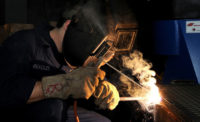While the flame-resistant fabrics in use today are the result of very modern technological advancements, the idea of treating materials to make them safer in the event of fire goes back centuries, and can even be traced to the ancient Romans, who used animal hides soaked in water to prevent siege towers from catching fire when the enemy shot burning arrows at them.
The evolution of FR has been driven by market forces and needs as wide-ranging as entertainment, the military, consumer goods and, of course, work wear. Demand led to experimentation and innovation. Applications in one sector – such as the military – found their way to other areas. Regulations also played a role in the development of FR in terms of mandating its use in certain products and limiting its effects on the environment.
Early innovators
The entertainment industry was one of the earliest FR innovators. Even before Shakespeare’s beloved Globe Theatre burned to the ground in 1613, fire was an ever-present danger at these popular public venues, which were built of wood and often had thatched roofs. Special effects like cannons (the culprit behind the Globe Theatre fire) were used to enthrall audiences. The idea of treating stage curtains to make them fireproof and help prevent the spread of fire from the stage to the auditorium was born, and the first iron safety curtain was installed at Drury Lane in 1794.1 Unfortunately, some early FR safety curtains were made with materials that contained asbestos.
Clay and plaster of Paris were also used to fireproof materials. A more sophisticated approach was taken by Obadiah Wyld, who developed a mixture of alum, ferrous sulfate and borax, which he patented in Great Britain in 1735. A 19th century French chemist named Joseph Louis Gay-Lussac took flame resistance to the next level with his discovery that ammonium phosphates and borax allow material to absorb more heat than it normally would before catching fire.2 The fact that these substances washed easily out of fabrics, though, made them less than ideal for FR clothing.
In 1912, however, chemist William Henry Perkins used stannic oxide to make FR garments which kept their protective qualities through repeated washing.
Infusion of money
Research and development into FR got a big boost from the American Armies Quartermaster Corp., which is responsible for supplying troops with clothing. The Corp.’s infusion of money and resources into R&D led to rapid discoveries and developments of substances that would enhance flame resistance while maintaining fabric strength and keeping fabrics soft to the touch.
The Flammable Fabrics Act of 1953 prohibited flammable textiles from being used in clothing and required clothing to pass Consumer Product Safety Commission (CPSC) tests before it could be sold. A focus on the safety of children in particular led to requirements that children’s sleepwear must pass flammability tests and self-extinguish if a flame causes it to catch fire.
As the FR industry matured, it was confronted by new challenges, such as concerns over the effects of certain flame-retardant organic compounds on human health and the environment.3 Some of these compounds have been banned or voluntarily phased out by manufacturers.
Today, FR continues to evolve and find new users in a wide range of industries. NFPA 70E Standard for Electrical Safety in the Workplace provides useful information for selecting and using FR apparel appropriate to a specific industrial setting or task.
1. www.theatrestrust.org.uk/resources/exploring-theatres/history-of-theatres/eighteenth-century-theatre
2. http://makezine.com/projects/make-43/joseph-gay-lussac-and-the-technology-of-fireproofing/
3. www.epa.gov/risk_assessment/expobox/chemicalclass/other-flam.htm








